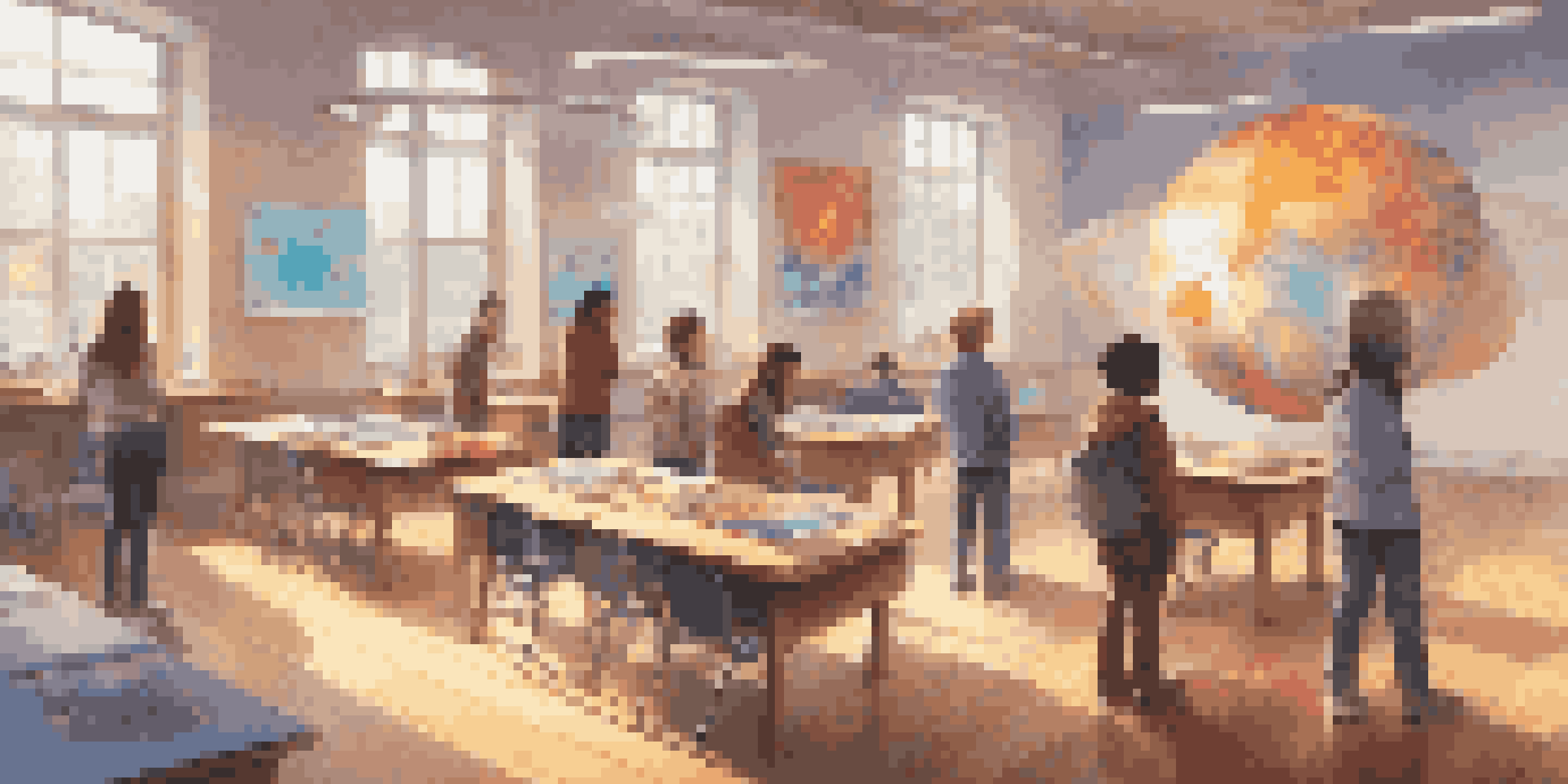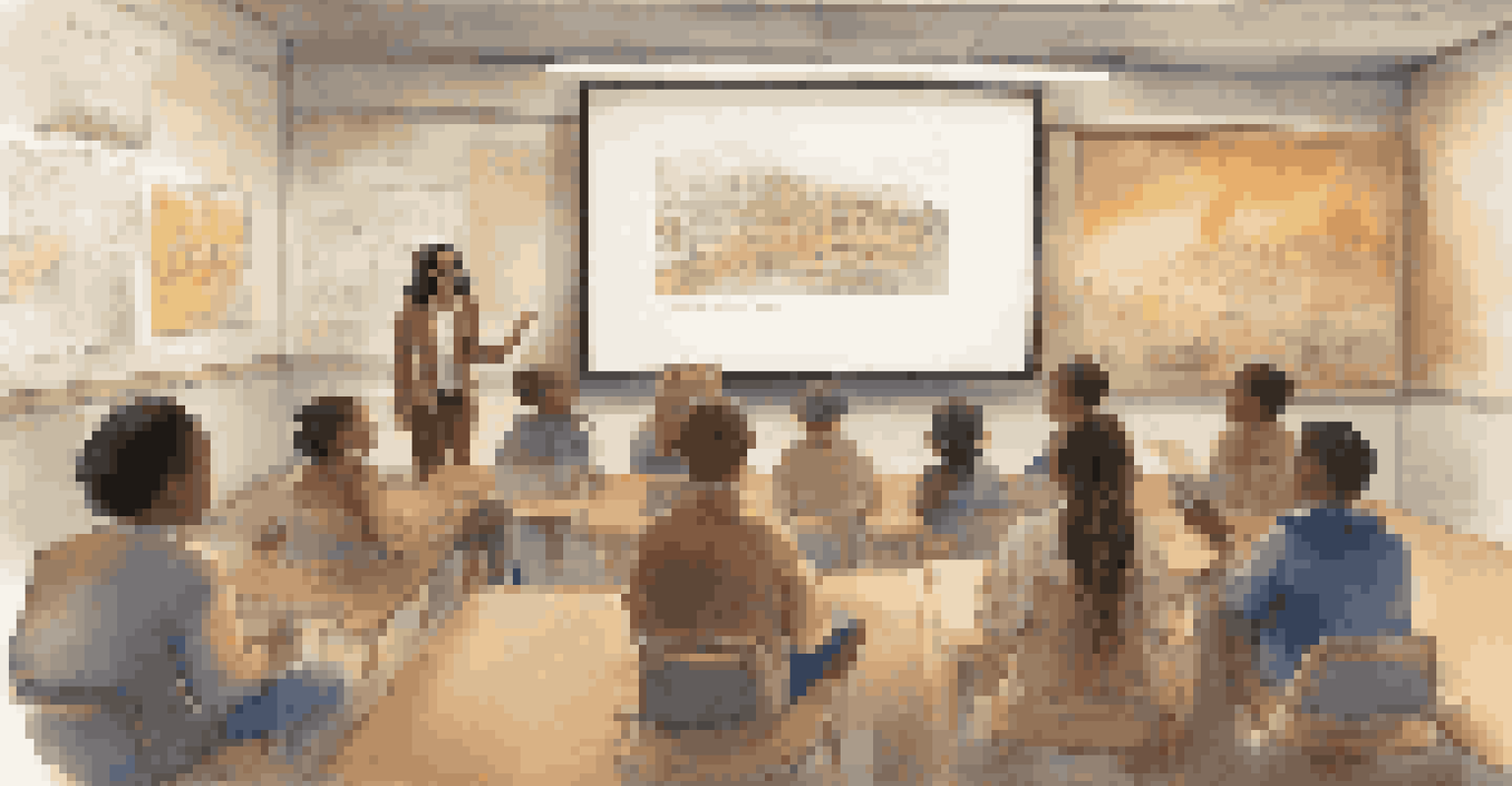Utilizing AR for Enhancing Digital Storytelling in Education

Understanding Augmented Reality in Education
Augmented Reality (AR) is a technology that overlays digital information onto the real world. In education, this means that students can interact with learning materials in a more immersive way. For example, when studying anatomy, students can visualize 3D models of the human body right in their classroom.
The future of learning is not in classrooms, but in innovative environments that blend the real and the digital.
This interaction not only makes learning more engaging but also helps students retain information better. By seeing and manipulating virtual objects, learners can grasp complex concepts more effectively. It’s like turning a textbook into a living, breathing experience.
As AR continues to evolve, it offers educators an innovative tool to enhance digital storytelling. This technology invites students to explore narratives in ways that traditional methods simply can't achieve, making lessons memorable and captivating.
The Role of Digital Storytelling in Education
Digital storytelling has become an essential teaching tool, allowing educators to convey information through narratives. Whether through videos, podcasts, or interactive presentations, stories can make subjects relatable and engaging. For instance, a history lesson can come alive when students hear the 'voice' of a historical figure telling their own story.

By incorporating digital storytelling, teachers can appeal to diverse learning styles, capturing the attention of visual, auditory, and kinesthetic learners. This approach not only enhances comprehension but also fosters empathy and critical thinking. Students learn to view subjects from different perspectives, enriching their educational experience.
AR Enhances Learning Engagement
Augmented Reality (AR) transforms traditional education by making lessons interactive and immersive, leading to better student involvement.
Moreover, digital storytelling encourages creativity among students. When they craft their own stories, they develop essential skills such as communication, collaboration, and problem-solving, preparing them for future challenges in an increasingly digital world.
Combining AR and Digital Storytelling
When AR is blended with digital storytelling, the results can be truly transformative. Imagine students reading a story about space exploration, and as they progress, they can see 3D planets and spaceships popping up around them. This not only enhances the narrative but also sparks curiosity and imagination.
Storytelling is the most powerful way to put ideas into the world today.
Such immersive experiences help students connect emotionally with the content, making learning more impactful. The combination of AR and storytelling creates a multi-sensory environment that captures attention and fosters deeper understanding. It's like stepping into a story rather than just reading about it.
Additionally, this approach allows for interactive learning. Students can take part in the story, make choices, and see the outcomes of those choices in real-time, which empowers them and makes learning a more active process.
Benefits of Using AR in Education
The benefits of utilizing AR in education are vast and varied. For starters, it enhances engagement; students are more likely to participate when lessons involve interactive elements. Furthermore, AR provides an opportunity for experiential learning, allowing students to use their senses to explore concepts beyond the classroom walls.
Moreover, AR can cater to different learning paces. Students who grasp concepts quickly can explore advanced topics, while others can revisit foundational ideas through interactive visuals. This flexibility helps create a more personalized learning experience, ensuring that all students can thrive.
Digital Storytelling Fosters Empathy
Integrating digital storytelling into education helps students connect emotionally with content, enhancing their understanding and critical thinking.
In addition to engagement and personalization, AR technologies can also bridge geographical gaps. Students in remote areas can access high-quality educational content and experiences that would otherwise be unavailable to them, democratizing education and fostering inclusivity.
Challenges of Implementing AR in Education
Despite its many advantages, implementing AR in education does come with challenges. One significant hurdle is the cost of AR technology and the necessary devices. Schools with limited budgets may struggle to provide the required hardware and software to facilitate AR learning.
Another challenge lies in teacher training. Educators need to be well-versed in AR tools and how to integrate them into their lessons effectively. Without proper training, the potential of AR can go untapped, leaving both teachers and students frustrated.
Lastly, there is a concern about screen time and its impact on students’ health. It’s crucial for educators to find a balance, ensuring that while AR enhances learning, it doesn’t replace essential hands-on experiences or lead to excessive use of devices.
Real-World Examples of AR in Education
Several institutions have successfully integrated AR into their curricula, showcasing its potential. For instance, the University of Maryland used AR to allow students to visualize historical battles, creating a more immersive learning environment. Such practical applications not only enhance engagement but also encourage students to think critically about historical events.
In K-12 education, platforms like Merge Cube let students hold and interact with 3D holograms in various subjects, from science to art. This hands-on approach fosters curiosity and makes learning enjoyable, helping students grasp complex topics easily.
Challenges of AR Implementation
Despite its benefits, the adoption of AR in education faces hurdles such as costs, teacher training needs, and concerns over screen time.
Moreover, companies like Google have developed AR tools that allow students to explore topics like geography and biology in interactive ways. By leveraging technology, educators can provide richer learning experiences that resonate with today’s tech-savvy students.
The Future of AR in Digital Storytelling for Education
The future of AR in digital storytelling seems bright and full of possibilities. As technology continues to advance, we can expect more innovative tools that will further enhance learning experiences. Future AR applications may enable even more interactive storytelling, allowing students to influence the narrative direction based on their choices.
Additionally, as AR becomes more accessible, we may see its integration across various learning environments, from classrooms to informal learning spaces. This could lead to more collaborative projects where students from different locations connect through shared AR experiences.

Ultimately, the combination of AR and digital storytelling could redefine education. By fostering creativity, critical thinking, and collaboration, AR has the potential to prepare students for a rapidly changing world, making learning not just informative but also transformative.